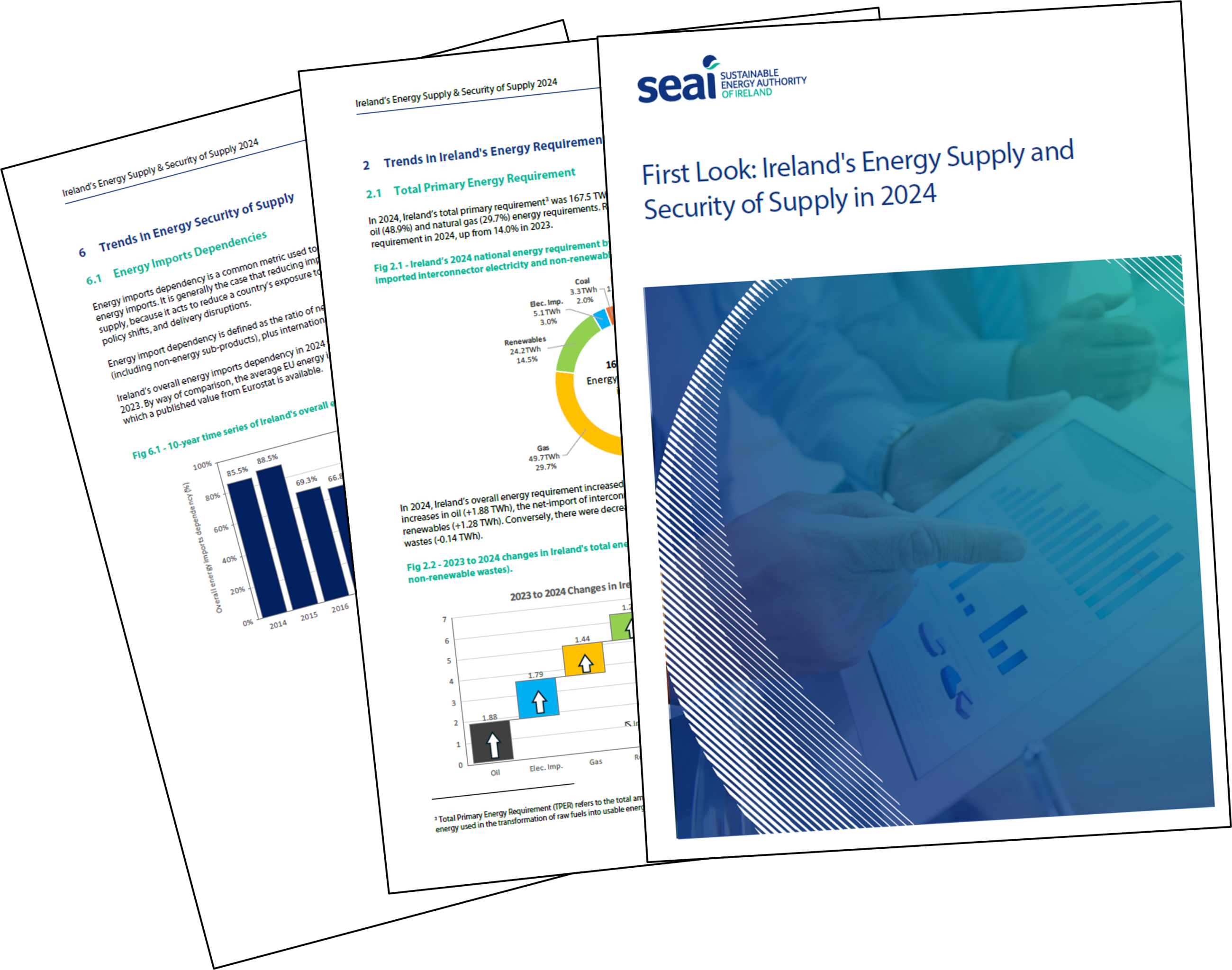Stat Chat: Ireland’s Energy Supply - A Tale of Two Streams
Like Dickens’ London and Paris, Ireland’s two key energy supply streams of imports and indigenous production exhibit a strong duality in their quantity and environmental impact.
Ireland’s Energy Supply and Security of Supply note for 2024
SEAI’s Energy Statistics Team has just published Ireland’s Energy Supply and Security of Supply note for 2024. This ‘First Look’ note summarises the imports, exports, and indigenous production of energy in Ireland. It includes data on energy-related emissions, levels of installed capacity for wind and solar, the international sources of our heating and transport oil-products, the level of national oil reserves held, and lots more! The note is full of interesting data and insights, and you can download it using the link below.
The 'worst of times' is behind
The good news for us – and Dickens – is that ‘the worst of times’ appears to be behind us. Ireland’s national energy-related emissions peaked in the mid-2000s, and in 2024, had fallen to their lowest level in over 30 years. Also, while still at relatively low levels, we have never been using more renewable energy in Ireland – renewables accounted for 14.5% of our total primary energy requirement in 2024.
However, there’s still a lot that we need to improve on. Fossil fuels continue to dominate Ireland’s energy supply – they accounted for 81.4% of Ireland’s primary energy last year, with the remaining 4.1% coming from other sources such as non-renewable wastes and the net-import of electricity. Let's start by looking at where Ireland’s fossil fuels and renewable energy come from.
Almost 80% of all energy needed to keep Ireland running in 2024 was imported. And that ‘energy import dependency’ figure is important, because it’s generally accepted that reducing it acts to increase a country’s security of energy supply. Having a lower energy import dependency reduces exposure to international market shocks, unexpected international policy shifts, and supply chain disruptions.
SEAI’s ‘First Look’ note also highlights the strong contrast in the quantity and environmental impact of the energy that Ireland imports and the energy that Ireland produces indigenously. Just like London and Paris in Dicken’s Tale of Two Cities, these two key energy supply streams couldn’t be more different.
On one hand, Ireland’s indigenous production of energy is comparatively clean. 61% of our indigenous energy in 2024 came from renewable sources – wind, solar, biomass, etc. and we now produce over twice as much renewable energy than we extract from the Corrib gas field.
In contrast, Ireland’s energy imports, and so the majority of our energy, remains stubbornly high in terms of quantity and carbon intensity (environmental impact). Ireland imported all its oil and coal, and just under 80% of its natural gas supply last year. In fact, 94% of the energy imported into Ireland was fossil fuel based.
We are in the ‘spring of hope’, but we need to strive for ‘the best of times’.
In Dickens’ world, revolution simmered. In the present real-world, a different, but equally profound kind of revolutionary shift is needed, if we, as individuals, and as a state are to play our part in avoiding a ‘winter of despair’ for the planet. In many ways, we are in the ‘spring of hope’ for a renewable future. We have many important choices to make and actions to take if we are to strive for ‘the best of times’ for the planet. We, as consumers, policymakers and businesses can’t afford to strive for anything less.
We must continue to improve how we produce and use our energy, to reduce the quantity of energy needed and reduce the environmental impact of the energy that we use. As well as this, by continuing to invest in indigenous production we will also strengthen our national energy security of supply in the near and long-term.
We can reduce our energy demand by becoming more energy efficient, and making more energy sufficient choices, for example:
- Using active and public transport where possible
- Swapping our ICEs for EVs
- Upgrading the efficiency of our homes, businesses and industry
- Rolling out district heating schemes in our communities
Many more actions are detailed in the Government’s Climate Action Plan.
All the while, we need to simultaneously reduce the impact of our energy use, by investing in indigenous capacity, through increasing renewables at a pace that will outstrip fossil fuel use. You can find information related to a range of licences and permits for renewable energy projects in Ireland on SEAI’s Single Point of Contact for Renewable Energy Consenting webpage. By achieving this, not only will it reduce the environmental impact of our indigenously produced energy even further, but all else being equal, it will have a knock-on effect of improving the flexibility of our energy supply streams too.


